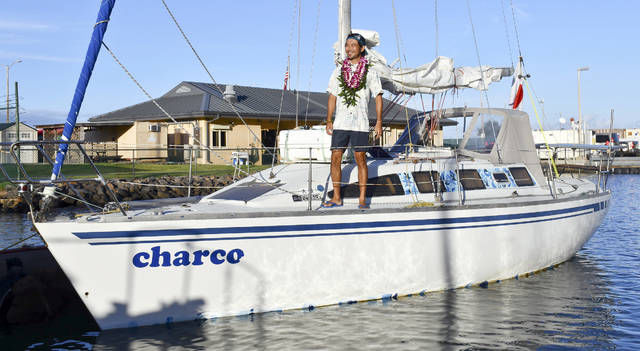NAWILIWILI — Lois Andersson of the Nawiliwili Yacht Club did not even notice the 30-foot sailboat amidst the flotilla of Toppers from the Kauai Sailing Association Sunday afternoon.
“No one told us,” Andersson said. “We had all the dingies out and all we saw was this boat with the American flag. The Japanese flag was scrunched up so we didn’t know who he was.”
Hiroshi Konno of Iwaki City, Japan, quietly slipped into the harbor, on one of his legs home to Japan following a solo sail to San Francisco.
“This is the longest trip I’ve done since starting to sail three years ago,” the 34-year-old Japanese citizen said. “I not nervous because I was so busy preparing for the trip.”
Konno departed Onahama Harbor in June aboard a 30-foot yacht named Charco, the Spanish translation for “puddles,” on his first voyage to cross the Pacific Ocean to the United States.
Art Umezu, acting as translator from the Mayor’s Office, said Konno’s dream is to re-establish Iwaki City’s yachting community after the Sun Marina small boat harbor was destroyed by the 2011 tsunami.
He won a contest sponsored by Iwaki City Mayor Toshio Shimizu celebrating Iwaki City’s 50th anniversary in 2016 and geared toward the future based on ideas from young people.
“I’m a world explorer,” Konno said. “I’ve traveled with backpacks and bicycles, but the only thing I have not been able to do is the ocean.”
After winning the Iwaki Dream Plan Contest, Konno quit his marketing job in Tokyo and concentrated on his solo sailing expedition, equipping the 30-foot yacht with provisions and equipment needed for the journey, which took 52 days to complete.
“I lived aboard the boat and practiced,” Konno said. “Three hundred and fifty-five days before leaving.”
Umezu said the path Konno took almost duplicated the buoy that washed up at Nohili two years following the tsunami disaster.
“Those were the first words I deciphered — ‘Onahama,’” Umezu said. “The buoy broke loose from Onahama, the same port Konno left on his trip to San Francisco. When he found out about the buoy that is displayed at the Port Allen Marina (Center), he got excited about visiting it to learn more.”
Konno said the trip was pretty much uneventful because of the equipment he had on Charco.
“I could sleep eight hours a day,” Konno said. “Auto pilot. You set the direction and it allows you to be able to sleep. The only trouble I had was outside San Francisco when the auto pilot broke. I couldn’t sleep for more than 50 hours until I landed.”
The return trip, via stops in Honolulu and Kauai, was more exciting.
“I had problems the last five days out of Honolulu,” Konno said. “The jib cut out, the engine broke, and the auto pilot went out. The starter was broken on the engine, and I didn’t know anything about starters. I had to calm my mind. I took some seasick pills not because I was seasick, but because the pills had some tranquilizers in it and that helped calm me down.”
Umezu said Konno’s stay on Kauai was made possible through Joe Borden of the state’s Department of Land and Natural Resources Division of Boating and Ocean Recreation, who provided a slip for Charco at the Nawiliwili Small Boat Harbor.
“I don’t know where I’m going next,” Konno said. “I want to see the South Pacific before returning to Japan.”







